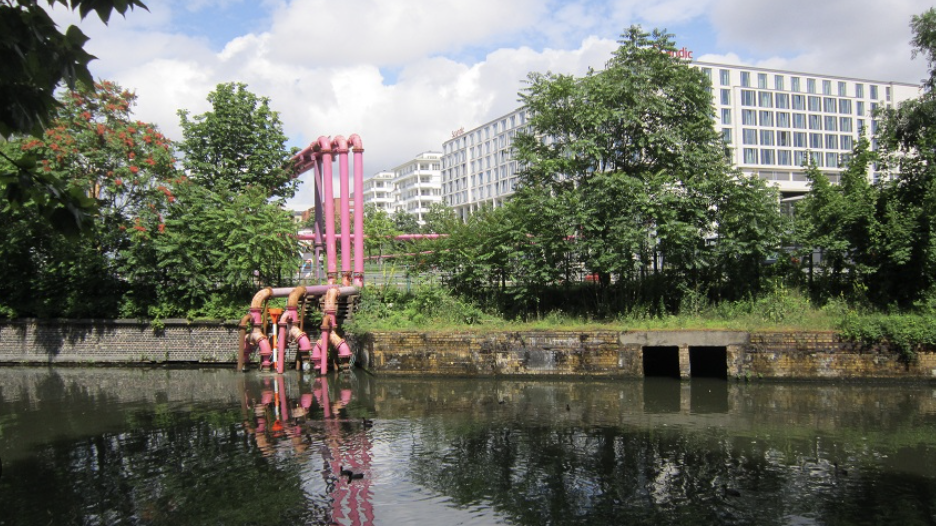Smart Materials, Smarter Cities
- Blue Moon Virtual
- Jul 22
- 3 min read
How Architecture is Adapting to a Changing Climate
Enter: Smart Materials.
The Berlin summer still holds promise not just of warmth and light, but of possibility.
Long afternoons near the canal are now joined by smarter infrastructure that adapts in real time: flood-responsive public spaces, solar paving, and cooling corridors shaped not only by human reaction, but diligent data.
Thanks to innovations piloted at places like the EUREF-Campus (European Energy Forum) and Siemensstadt Square, the city is becoming a living laboratory for resilient, sustainable design.
Yes, July 2025 has brought fourth erratic weather, sudden rains and sharp heat, but we can't submit to the negatives when it comes to the climate, and how we exist amongst it. We must think in solutions.
Thankfully, architecture and technology are two of humanity’s oldest tools for adaptation, both born from the need to respond to our environment and the climate we live within. In Berlin, this legacy is visible even in the everyday: the city’s iconic pink overhead drainage pipes, once a quirky curiosity, were developed to manage high groundwater levels during construction. What began as a practical response has since become part of the urban identity.
Today, similar adaptive thinking is guiding new innovations such as AI powered drainage systems, climate responsive facades, and circular material use. Though these technologies may feel unfamiliar or even disruptive now, they too will become part of the city’s fabric, the next layer in Berlin’s ongoing story of resilience.
That’s why our tools must do more than protect, they must connect. Design must be proactive, empathetic, and global in scope. Grounded in responsibility and driven by the technology we shape. Smart materials offer a vital pathway forward. These are not just high-tech novelties, they’re foundational components in reshaping how buildings interact with the environment.
The Tools
1. Passive Cooling Systems Instead of relying on energy-intensive air conditioning, buildings are increasingly designed with phase-change materials (PCMs) and thermochromic glass that regulate interior temperature naturally. In cities like Frankfurt and Munich, offices are now using passive façades that adjust to heat gain and light exposure in real time — reducing energy loads and increasing user comfort, all while preparing for more frequent temperature spikes.
2. Green Roofs and Living Walls Berlin is ahead of the curve here. With subsidies supporting green roofs since 2013, the city is a case study in how living surfaces can insulate buildings, absorb rainwater, and contribute to biodiversity. But more importantly, they combat the urban heat island effect — a phenomenon growing more dangerous as cities densify.
3. Low-Carbon and Carbon-Storing Materials From hempcrete to mycelium insulation, architects across Germany are experimenting with materials that either produce significantly fewer emissions or actively store carbon. In Hamburg, a new residential block is being built using cross-laminated timber (CLT), a renewable alternative to concrete that captures carbon during its growth phase. It's a material as intelligent as the design behind it.
The Role of 3D Rendering and Simulation
Adapting to climate realities requires a rethinking not just of what we build, but how we design. 3D rendering has become essential in simulating environmental performance and visualizing the interaction of smart materials with real-world climate data.
Take the Haus der Statistik redevelopment in Berlin. Here, 3D simulations have helped planners visualize airflow, solar exposure, and green space integration across multiple phases of construction — ensuring not just aesthetic quality, but long-term sustainability.
Or look to The Wood Factory in Stuttgart, a mixed-use project modeled entirely with parametric tools. Architects were able to simulate the behavior of bio-based materials under different weather extremes, enabling smarter, more resilient design decisions before a single beam was laid.
Even beyond Germany, we see examples of local materials and environmental intelligence guiding low-tech, high-impact solutions. In the Turkish Riviera, for instance, many homes use black barrels filled with water on their roofs to absorb heat during the day and supply warm water inside at night — a passive system rooted in traditional knowledge and climate responsiveness. It’s proof that adaptation doesn’t always require new invention; sometimes it just requires attention to what’s already working.
A Future Built with Empathy
This isn’t about aesthetics or trends. It’s about survival of both people and cities. Smart materials and rendering technologies are not silver bullets, but they are powerful tools when used with intention. The climate crisis is already here, and the architecture we create today will determine how we live through the next century.
Empathy in design means learning from every context from high-tech labs in Berlin to sunbaked rooftops in Antalya. It means letting materials respond to place, letting tools visualize futures before they’re built, and allowing our built environment to care — for us, and for the planet.
Berlin’s grey July skies may not feel like a crisis. But the storm is only beginning and we must build like we know it.



























Comments